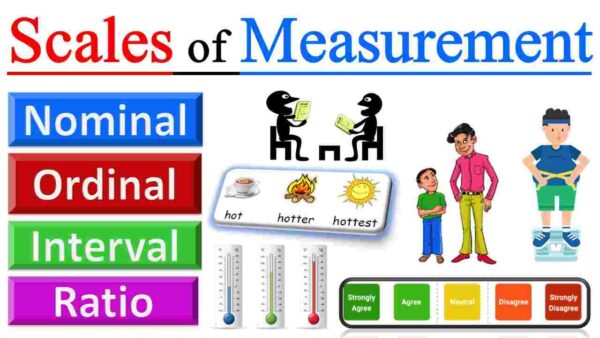Measures of central tendency are statistical measures that describe the typical or central value of a dataset. The three commonly used measures of central tendency are the mean, median, and mode. Let’s explore each of them with examples:
In statistics, there are four commonly recognized scales of measurement: nominal, ordinal, interval, and ratio. These scales represent different levels of measurement and determine the types of statistical analyses that can be performed on the data. Let’s explore each scale with examples:
| Scale of measurement | Properties | Examples |
|---|---|---|
| Nominal | – Data is classified into categories | Hair color, eye color, gender |
| Ordinal | – Data can be ranked in order | Finish time in a race, customer satisfaction survey |
| Interval | – Data can be ranked in order, and the difference between the ranks is meaningful | Temperature in degrees Celsius, time in minutes |
| Ratio | – Data can be ranked in order, the difference between the ranks is meaningful, and the ratio between two values is meaningful | Weight in pounds, distance in miles |
- Nominal Scale: The nominal scale represents categorical or qualitative data where values are assigned to categories without any inherent order or numerical meaning. In this scale, data can only be classified into different categories. The nominal scale is the simplest scale of measurement. It is used to classify data into categories that have no inherent order. For example, you could use a nominal scale to classify people by their hair color (blond, brunette, redhead, etc.). Nominal data cannot be meaningfully ordered or added or subtracted. Example: Eye colors (blue, green, brown) or marital status (single, married, divorced) are examples of nominal data. It’s important to note that there is no natural ordering or hierarchy among the categories.
- Ordinal Scale: The ordinal scale involves categorical or qualitative data that have a natural order or ranking. The intervals between the categories are not necessarily equal, but the data can be ordered. The ordinal scale is a more complex scale of measurement than the nominal scale. It allows you to rank data in order, but the distances between the ranks are not meaningful. For example, you could use an ordinal scale to rank athletes by their finish time in a race. Ordinal data can be meaningfully ordered, but it cannot be added or subtracted. Example: Rankings in a competition (1st place, 2nd place, 3rd place) or educational levels (elementary, middle, high school) are examples of ordinal data. While we can determine the order, we cannot determine the exact magnitude of differences between the categories.
- Interval Scale: The interval scale represents quantitative data where the intervals between values are equal, but there is no true zero point. This scale allows for meaningful comparisons of both order and magnitude. The interval scale is a scale of measurement that allows you to rank data in order and to calculate the difference between the ranks. However, the interval scale does not have a true zero point. For example, you could use an interval scale to measure temperature in degrees Celsius. Interval data can be meaningfully ordered, added, subtracted, and divided. Example: Temperature measured in Celsius or Fahrenheit is an interval scale. The differences between 10°C and 20°C and between 80°F and 90°F are the same, but zero does not indicate the absence of temperature.
- Ratio Scale: The ratio scale also represents quantitative data, but it has a true zero point. It possesses all the characteristics of the interval scale and allows for the ratio between values to be calculated. The ratio scale is the most complex scale of measurement. It allows you to rank data in order, to calculate the difference between the ranks, and to calculate the ratio between two values. The ratio scale has a true zero point, which means that zero represents the absence of the quantity being measured. For example, you could use a ratio scale to measure weight in pounds. Ratio data can be meaningfully ordered, added, subtracted, divided, and multiplied. Example: Age, height, weight, or income are ratio scales. A value of zero in these measurements indicates the absence of the attribute being measured.
These scales of measurement provide a framework for understanding the nature of the data and guide the selection of appropriate statistical techniques and analyses. It is crucial to consider the scale of measurement when interpreting data and choosing the appropriate statistical methods.




